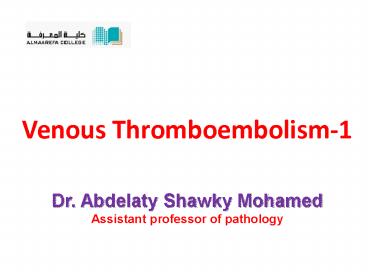Venous Thromboembolism-1 - PowerPoint PPT Presentation
1 / 30
Title:
Venous Thromboembolism-1
Description:
Title: PowerPoint Presentation Last modified by: Abdulaty Shawky Created Date: 1/1/1601 12:00:00 AM Document presentation format: On-screen Show (4:3) – PowerPoint PPT presentation
Number of Views:210
Avg rating:3.0/5.0
Title: Venous Thromboembolism-1
1
Venous Thromboembolism-1
Dr. Abdelaty Shawky Mohamed Assistant professor
of pathology
2
Topics
- 1. Pathophysiology of VTE.
- 2. Clinical presentation of VTE.
- 3. Investigations of VTE.
3
1. Pathophysiology of VTE
4
Hemostasis and Thrombosis
- Hemostasis is the physiologic process that
maintains the blood in a fluid state in normal
vessels and to induce a rapid and localized
hemostatic plug at a site of vascular injury to
stop bleeding.
5
- Thrombosis is the pathologic process opposite to
hemostasis it can be considered an inappropriate
activation of normal hemostatic processes,
resulting in the formation of a (thrombus) in
uninjured vessel or after minor injury.
6
- Both hemostasis and thrombosis are regulated by
three general components. - 1. The vascular endothelium.
- 2. Platelets.
- 3. The coagulation cascade.
7
- Q. What is the role of endothelial cells in
hemostasis and thrombosis?
8
- Endothelial cells have both antithrombotic
activities preventing thrombosis in normal blood
vessel and also have prothrombotic activities
favoring thrombosis in injured blood vessels. - The balance between endothelial antithrombotic
and prothrombotic activities critically
determines whether thrombus formation,
propagation, or dissolution occurs
9
Antithrombotic Properties
- Antiplatelet effects by secretion of
prostacyclin (PGI2) and nitric oxide. Both
mediators are potent vasodilators and inhibitors
of platelet aggregation. - Anticoagulant effects These effects are mediated
by - a. Thrombomodulin receptors for (thrombin) to
block its action and also to activate protein C
which in turn inactivate factors V and VIII. - b. Heparin-like molecules receptors for
anti-thrombin III to block factors IX and X. - c. Release of tissue factor inhibitor. These
inhibit the coagulation pathway.
10
- Fibrinolytic effects Endothelial cells
synthesize tissue-type plasminogen activator
(t-PA), promoting fibrinolytic activity to clear
fibrin deposits from endothelial surfaces .
11
Prothrombotic Properties
- Platelet effects
- - Endothelial injury leads to adhesion of
platelets to the underlying extracellular matrix
this is facilitated by endothelial production of
von Willebrand factor (vWF), an essential
cofactor for platelet binding to subendothelial
collagen.
12
- Procoagulant effects Endothelial cells
synthesize tissue factor, which activates the
extrinsic clotting cascade. - Antifibrinolytic effects Endothelial cells also
secrete inhibitors of plasminogen activator
(PAIs), which inhibits fibrinolysis.
13
Coagulation cascade
14
Thrombosis
15
- Definition of thrombosis
- - Formation of a solid mass composed of the
circulating blood elements, inside CVS system
(blood vessels or heart) during life.
16
Causes of thrombosis
- - There are 3 major factors which predispose to
thrombosis (Virchows triad) - 1. Endothelial damage.
- 2. Slowing turbulence of blood flow.
- 3. Blood hypercoagulability.
17
- 1. Endothelial damage
- - Endothelial damage may be
- a. Mechanical trauma, repeated tourniquet
- b. Inflammatory arteritis, phlebitis and
endocarditis. - c. Degenerative atherosclerosis, hypertension..
- - The injured endothelium becomes swollen with
rough surface.
18
- 2. Slowing turbulence of blood flow.
- - Occurs in
- Left atrium in mitral stenosis.
- Leg veins in varicose veins and bed-ridden heart
failure patients. - Inside aneurysmal sacs.
19
- 3. Blood hypercoagulability
- I. Genetic (inherited)
- Mutation of factor V gene.
- Mutation of prothrombin gene.
- - In both conditions the resulting factor V and
prothrombin are not prone to degradation and have
a sustained thrombotic actions.
20
- Protein C and protein S deficiency
- These are natural anti-coagulant proteins.
- Their deficiency leads to hypercoagulability
state.
21
- II. Acquired
- Prolonged bed rest or immobilization.
- Myocardial infarction.
- Tissue damage (surgery, fracture, burn).
- Cancer.
- Oral contraceptive pills.
22
Pathogenesis (Mechanism) of thrombosis
- Endothelial injury leads to
- 1. Exposure of sub-endothelial collagen promote
platelet aggregation. - 2. Release of tissue factor promote fibrin
formation.
23
- I. Exposure of sub- endothelial collagen
- a. Platelets adhesion to the exposed collagen
(this is mediated by factor VIII released from
endothelial cells). - b. Platelet activation and release of Thromboxane
A2 (potent vasoconstrictor and induce platelet
aggregation)
24
- II. Release of the tissue factor (from
endothelial cells) that stimulate the coagulation
cascade to form thrombin that convert fibrinogen
into fibrin. - The end result is fibrin network entangling
aggregated platelet (Thrombus)
25
- The lumen of blood vessel is occupied by a red
mass which is adherent to the vessel wall at an
area called the head of the thrombus .
26
Gross picture of the thrombus
27
Microscopic picture of thrombus
28
(No Transcript)
29
- These are "lines of Zahn" which are the
alternating pale pink bands of platelets with
fibrin and red bands of RBC's forming a true
thrombus.
30
Thanks

